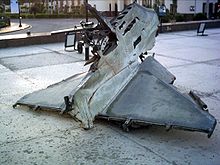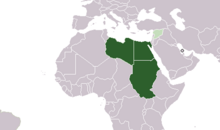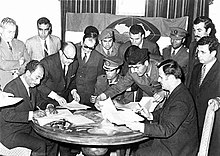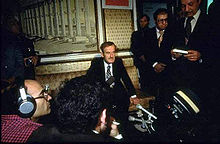Federation of Arab Republics
|
|||||
| navigation | |||||
|
|||||
| Official language | Arabic | ||||
| Capital | Cairo | ||||
| Form of government | republic | ||||
| Residents | 50,400,000 | ||||
| surface | 2,962,130 km² | ||||
| President of the Union | Anwar as-Sadat | ||||
| Prime Minister of the Union Government | Ahmed al-Khatib | ||||
| Members | |||||
| Existence period | 1971-1977 | ||||
As the Federation of Arab Republics (abbreviated FAR ; Arabic اتحاد الجمهوريات العربية ittihād al-dschumhūriyyāt al-ʿarabiyya , DMG ittiḥād al-ǧumhūrīyāt al-ʿarabīya 'Union of Arab Republics') was the name given to the state connection between Egypt and Libya and Sudan or Syria from 1970–1977. Although ittihād would literally be better translated as “union” or “unification”, in contrast to the somewhat more substantial Egyptian-Syrian Union from 1958–1961, 1970–1977 it wasnot a unitary state, but a confederative union of states .
Just as the United Arab Republic once operated under the same name for various unification projects, the Federation of Arab Republics also comprised different, but divergent, amalgamations of the same partners between 1970 and 1977 It was agreed on April 17, 1971 and put into effect by referendum on January 1, 1972. An Egyptian-Libyan Union was to emerge within this federation in 1973, the failure of which ultimately also led to the failure of the federation.
initial situation
The Federation of Arab Republics stood in the tradition of the many fruitless Arab efforts to unite the “Arab nation” into a single state .
But as early as 1965, Egyptian President Gamal Abdel Nasser had warned against too rapid Arab unification without prior economic integration. After his defeat in the Six Day War , he had to give up his pan-Arab and revolutionary republican engagement and from then on was dependent on Soviet economic and military aid ( war of attrition ) on the one hand and financial aid from conservative Saudi Arabia on the other. With the territories occupied by Israel in 1967 ( Sinai Peninsula , Gaza Strip ), 70% of Egyptian oil production had been lost and a million refugees had entered the country. The efforts of the Egyptian leadership were therefore directed towards regaining the lost territories and reopening the Suez Canal , the closure of which by the Israelis meant heavy economic losses for Egypt.
As early as May 1969, a military coup led by Jafar an-Numairi had brought a pro-Egyptian regime to power in Sudan. In June 1969, both Syrian President Nureddin al-Atassi had declared that his government was planning a union between Syria and Egypt and other revolutionary Arab states, and Iraqi President Hasan al-Bakr that an Iraqi-Syrian union was the beginning of an Arab one Union. More than a Syrian-Iraqi military alliance, however, did not come about. On September 1, 1969, a group of young, pro-Egyptian officers led by Muammar al-Gaddafi carried out a coup in Libya and overthrew the monarchy. Gaddafi, who appeared as an ardent supporter of Nasser, immediately tried to win his idol for a unification of Libya and Sudan with Egypt.
The unification of Libya and Egypt seemed to offer objective advantages for both sides. The labor shortage in the sparsely populated but prosperous Libya thanks to the oil industry was complemented by the population surplus in Egypt, which suffers from high unemployment. The Libyan oil billions offered Egypt the chance to become independent of Saudi loans. At the request of Egypt, Libya left the Common North African Market of the Maghreb in 1970 and turned to the Nile Valley.
Union of Arab Republics
See also: Libyan-Egyptian striving for unity
Egyptian-Libyan-Sudanese Federation
Gaddafi's first attempt at unification was also Nasser's last. Initially, however, the Egyptian president did not agree to more than one political alliance, a revolutionary Arab front with Libya and Sudan (Charter of Tripoli, December 28, 1969). A trilateral federation agreement was not reached until April 20, 1970, but Nasser died suddenly on September 28, 1970.
On November 4, 1970 Nasser's successors Anwar al-Sadat , Gaddafi and Numeiri began to negotiate the formation of a federation. The three politicians formed a United Political Leadership on November 8, 1970 to prepare for unification. After the military coup in Syria, the new Syrian Prime Minister Hafiz al-Assad joined on November 27, 1970 . In December 1970, Egypt, Libya, Sudan and Syria agreed to form a Federation of Arab Republics .
Apparently, Sadat initially continued Nasser's course, but in fact he strove to turn away from (failed) Nasserism through economic and domestic "liberalization" and rapprochement with the United States and Saudi Arabia. With the Federation at his back, Sadat was able to underline his claim to leadership and in May 1971 also eliminate the rivals within the Egyptian leadership who opposed the impending change of course (above all the Nassist Vice President Ali Sabri ) after he had accused them of an attempted coup.
Egyptian-Libyan-Syrian Federation
On April 17, 1971 (Syria's national holiday), the heads of state of Egypt, Libya and Syria (Assad had also become Syrian President in March 1971) finally sealed the Federation of Arab Republics in Benghazi , Libya . Sudan, which was initially still preoccupied with internal problems ( South Sudan conflict, directional struggles in the Revolutionary Council), was to join at a later date. In addition, the constitution of the federation provided for the - never happened - accession of further Arab states. At the head of the federation was a presidential council made up of the heads of state of the member states. The Egyptian President Anwar as-Sadat was elected as the first chairman . The chair should change every two years. Libya's revolutionary leader al-Gaddafi and Syria's President al-Assad were vice-presidents. Other organs were a Federal Council of Ministers appointed by the Presidency Council (Union government), a six-member Federal Constitutional Court and a Federal National Assembly consisting of delegates from the individual parliaments. The National Assembly, each with 20 representatives from the three states, met for its constituent session in March 1972 and elected the Libyan Kheiry as-Saghir as chairman. The Syrian Ahmed al-Khatib was tasked with forming a union government, which, among other things, the Egyptian Muhammad Fathallah al-Khatib as Foreign Minister and the Libyan Muhammad al-Khawaga as Minister of Public Services.
Similarities and opposites
The Union's primary purpose was an economic, military and cultural alliance. However, the goals of the three states and their leaders were very different:
- Sadat intended to step out of Nasser's shadow by planning to succeed where Nasser had failed. In another war against Israel, he wanted to regain the Egyptian territories that Nasser had lost in 1967 (Sinai, Gasa). For this, Israel should only be weakened to the point that it could be forced into negotiations, but not completely defeated, because otherwise the United States would uncompromisingly take the Israeli side. For this war, the Egyptian-Syrian military alliance was more important than the later agreed union with Libya, which did not represent any significant military reinforcement. The Libyan Air Force alone, with its modern Dassault Mirage fighter planes, was useful, but in fact the small Libyan Air Force was already integrated into the much larger Egyptian Air Force .
- While Sadat was striving for a limited war from the start, Assad hoped for the full deployment of the entire Egyptian armed forces to regain the Golan Heights lost to Israel in 1967 in the shadow of an Egyptian victory . Unlike Sadat, who, as Nasser's vice-president, “inherited” his successor, Assad came to power through a military coup against the government that had lost the Golan Heights in the first place. Recovering them had become a question of legitimacy for Assad and more important than full unification.
- Gaddafi saw himself as the ideological heir of Nasser and wanted his successor Sadat to continue Nasser's policy, but initially Gaddafi was ready to subordinate himself to Sadat, who was over 23 years older. He considered a limited war against Israel to be a waste of Arab resources (Libya had not lost any territories). He later accused Sadat of having achieved the return of Sinai through negotiations in 1972, even without a loss-making war. It was only after Israel shot down a Libyan transport machine in February 1973 that Gaddafi gradually went on a war course.
- Above all, Numeiri had hoped for Egyptian military and Libyan financial aid from the federation for his war against the rebels in South Sudan . Most Sudanese were rather skeptical about a complete “ unity of the Nile Valley ”. In fact, it was Egyptian troops and the Libyan Air Force who brought Numeiri back to power in Khartoum after a pro-communist coup on July 22, 1971 . With the accession of non-African Syria, however, Numeiri had to recognize that the Egyptian-Libyan engagement would concentrate primarily on the Middle East conflict and on supporting Syria instead of supporting Sudan. Sudan therefore initially withdrew from the federation and granted autonomy to the insurgent South Sudan in February 1972.
Counter-proposal from Iraq
As a reaction to the Jordanian-Palestinian Federation proposed by Jordan's King Hussein , Iraq pushed in March 1972 for a new edition of the Egyptian-Iraqi-Syrian Union, which had failed in 1963, as a union of the Arab republics (including the PLO), which Egypt referred to the already existing Federation of Arab Republics was rejected. Relations between Syria and Iraq, where two warring wings of the Ba'ath Party ruled, were also strained by the Syrian Euphrates Dam and the Iraqi oil pipeline running through Syria. However, Egypt offered Iraq to join the federation.
Iraq renounced, but assured Egypt and Syria strong military support in the event of a new war against Israel and suggested a joint high command, which was rejected by Egypt and Syria. As early as 1971, Iraq had to withdraw its troops, which had been guarding the Israeli front since 1967, from Syria and Jordan.
Iraq then concluded a friendship treaty with the Soviet Union in April 1972, which in turn took Libya as an opportunity to break off relations with Iraq for the time being.
Sudan's withdrawal
At the end of 1972, Sudan's connection initially seemed obsolete. Tensions arose between Sudan and Libya in September 1972 when Khartoum prevented the transport of Libyan troops through Sudanese airports in support of the Ugandan dictator Idi Amin . After the removal of pro-Egyptian ministers from the Sudanese cabinet, Egyptian-Sudanese relations also deteriorated. At the request of Egypt, the Sudanese troops stationed on the Suez Canal had to be withdrawn in October 1972. (Exactly one year later, in the October 1973 war, Sudan again sent troops alongside Egypt to the Sinai Front.)
Invitation from Tunisia
Libya's revolutionary leader Gaddafi, on the other hand, urged Tunisia to join in December 1972 . His recruiting, which was also directed at Chad , questioned the Arab character of the federation. In 1973, Tunisian President Habib Bourguiba proposed instead an amalgamation of Tunisia with Libya and Algeria ("United States of North Africa") against Morocco and Egypt.
Egyptian-Libyan Union
As early as February 1972, Gaddafi Sadat had proposed that Libya and Egypt should form a more solid union within the federation, i. H. to merge to form a unitary state. On August 2, 1972, Gaddafi and Sadat agreed to completely merge their states into one union by September 1, 1973. The Egyptian-Libyan unitary state was to again bear the name of the United Arab Republic , which Egypt had just abandoned. On September 10, 1972, the two heads of state established a Supreme Planning Council (United Political Command) and a constituent assembly made up of 50 Egyptian and 50 Libyan government representatives worked out a constitution. The Egyptian Murad Ghaleb became Resident Minister in Libya and the Libyan Mohammed Abu Bakr Ben Jussef (Youssef) became Resident Minister in Egypt. Nevertheless, Sadat kept delaying the realization of the Egyptian-Libyan Union. Therefore, in April 1973, Gaddafi called on the Egyptians to "revolutionize the people" against Sadat. He had previously stated that he would resign so as not to be an obstacle to the union with Egypt.
Frustrated by the stagnation of the unification process, Gaddafi tried in July 1973 to force the implementation of the union through a peaceful march of thousands of Libyans to Cairo . With over 50,000 participants, the “Arab Unity March” started on July 18, 1973 from the Tunisian border in order to accelerate the agreed merger with neighboring Egypt. The demonstrators took a message of unity written in blood with them on the 2,000 km walk. Muammar al-Gaddafi declared in the Mosque of Tripoli “Egypt has the Nile, while we have the oil and the land” and “Egypt has the workforce, and both countries need and complement each other.” But the mass protest did not achieve union with Egypt , Sadat had the "March to Cairo" stopped east of Mersa Matruh . On the agreed date (September 1, 1973), the union had not come into being.

Instead, on July 23, 1973, on the anniversary of the Egyptian revolution, Sadat declared the policies of the United States to be hostile to peace and affirmed that Egypt was determined to recapture the Israeli-occupied territories. On October 6, 1973, Egypt and Syria started the war without having involved Libya or Iraq in the preparations or even having consulted them. Nevertheless, immediately after the fighting broke out (contrary to an agreement with France ) , Gaddafi sent over 40 Libyan mirages and one billion US dollars in support. Iraqi and Sudanese troops came to the aid of the federation on the Suez Front, while Morocco and Jordan also sent some troops to support the Golan Front in addition to the Iraqis. But Sadat quickly broke off the offensive and delayed the consistent fight against an Israeli counter-offensive. Gaddafi rejected the armistice with Israel that had already been concluded on October 24, 1973 as a result of the military stalemate. He therefore initially turned back to Tunisia, but the Arab Islamic Republic agreed with Habib Bourguiba in January 1974 also failed.
After the first Egyptian-Israeli troop unbundling agreement (January 18, 1974) and Egypt's failure to intervene when new fighting broke out on the Syrian-Israeli front in March 1974, Gaddafi stopped financial support for Egypt on March 28, 1974. Sadat turned to Saudi Arabia, which immediately granted Egypt generous loans, subsidies, and financial injections (over $ 1.1 billion by 1975, another $ 2.2 billion by 1977) the Libyan ex-king Idris, overthrown by Gaddafi, to Cairo. The already failed union was effectively over, but despite the tensions, another 153,000 guest workers from Egypt came to Libya. On April 18, 1974, members of the "Islamic Liberation Front" allegedly supported by Libya undertook an attack on the military technical academy in Cairo- Heliopolis , in which 11 people were killed. In July 1974 tensions intensified. A letter from Sadat dated July 31, 1974 accusing Gaddafi of instigating unrest in Egypt and offering the return of the Libyan Mirage fighter planes was not accepted. Finally, Sadat took in the Libyan major Omar Abdullah al-Muhaishi , who had attempted a coup against Gaddafi in August 1975. After the Federal National Assembly met for the last time in 1975, Sadat adjourned the meeting scheduled for March 1976. Thereupon Gaddafi expelled tens of thousands of Egyptian guest workers in March 1976 (over 250,000 by 1977).
Egyptian-Syrian Union
Despite the alliance with Egypt, Syria was saved from defeat in 1973 only by hastily deployed Iraqi tank and air defense units (Israeli troops had advanced even further than in 1967 and had even attacked Damascus ), which the Syrian regime mistrusted. After the withdrawal of the Iraqis (in protest against the Syrian-Israeli armistice agreement of October 22, 1973) and a first Egyptian-Israeli troop unbundling agreement on January 18, 1974, Syria was also forced to enter into such an unbundling agreement with Israel on May 31, 1974. Syria, however, like Iraq, Libya and the internal PLO opposition front , sought to continue the struggle and therefore refused to participate in the Geneva Middle East negotiations. The second Egyptian-Israeli unbundling agreement in September 1975 (Sinai Agreement) described Syria as "treason".
After this agreement, Syria could no longer hope for Egyptian assistance and therefore first sought an alliance with Jordan, President Assad and King Hussein I agreed on a United Political Leadership in 1975 . As a result of the Syrian intervention in the Lebanese civil war , Syrian-Egyptian rapprochement was temporarily restored from September 1976. Syria had intervened in Lebanon on behalf of the predominantly Christian right- wing front. Iraq and Libya had unsuccessfully urged Syria not to oppose the predominantly Muslim left-wing front allied with the PLO . Sadat was also concerned about the Syrian approach, but even more about the Libyan-Iraqi criticism of the Syrian invasion. Assad needed Sadat's backing for his Lebanon policy and, at Egypt's instigation, the Arab League approved Syria's actions in October 1976. On December 18, 1976 and February 4, 1977, Assad and Sadat agreed on a Political Supreme Command to prepare a union between Egypt and Syria.
Egyptian-Syrian-Sudanese Federation
At the same time as the rapprochement between Egypt and Syria, relations between Egypt and Sudan had become closer again. After an attempted coup in July 1976, which Numeiri suspected to be the Libyan revolutionary leader Gaddafi, Sudan had concluded a military alliance with Egypt.
At a meeting between Numeiri and Sadat and Assad from February 25 to March 1, 1977 in Khartoum, the Sudanese president expressed his desire to join the Egyptian-Syrian union project. Once again a United Political Leadership was agreed to prepare a Federation of Arab Republics consisting of Egypt, Syria and Sudan . Various cooperation agreements were concluded at the summit for this purpose. Even Somalia expressed a desire to join. Libya responded by establishing a people's republican form of government and proclaimed an independent Jamahiriya .
The Egyptian-Sudanese alliance directed against Libya further intensified Egyptian-Libyan relations. Gaddafi expelled hundreds of thousands of other Egyptian guest workers. In their return flow, Libyan demonstrators mingled and called for a renewed “unit march”. As a result, there was even a brief Libyan-Egyptian border war in July 1977 , which, incidentally, was ended not by Syrian but by Algerian mediation. However, with the negotiating trip of Egyptian President Sadat to Jerusalem and his speech to the Israeli Knesset on November 20, 1977, the Egyptian-Syrian-Sudanese Federation finally broke up. While Numeiri showed understanding for Sadat's going it alone, Assad and Gaddafi disgusted him.
epilogue
On the same day of Sadat's trip to Jerusalem, on November 19, 1977, one day before Sadat's speech in the Israeli Knesset, Gaddafi ordered the abolition of the Federation flag and the Federation coat of arms and replaced them with a plain green Libyan flag and one of Egypt replace the heraldic falcon looking away. On December 5, 1977, Gaddafi and Assad finally dismissed the Federation Presidency Council by decree, which had not met since 1973. They first moved the headquarters of the Federation to Tripoli , and there in December 1977 Gaddafi invited Arab heads of state to form a front of steadfastness to oppose a separate Egyptian-Israeli peace .
In September 1980, Gaddafi and Assad instead agreed a Libyan-Syrian Union , and in March 1980 Syria had also replaced the federation flag and coat of arms with Syrian symbols. It was not until October 1, 1984 that Egypt formally declared its withdrawal from the Federation of Arab Republics and was the last to replace the Federation flag and coat of arms.
The Libyan-Syrian Union did not come about, nor did the gradual integration of the two states of the Nile Valley between Egypt and Sudan in 1979 and 1982–1985.
literature
- Martin Stäheli: Syrian foreign policy under President Hafez Assad. Franz Steiner Verlag, Stuttgart 2001, ISBN 3-515-07867-3 .
- Heinz Halm : The Arabs - from pre-Islamic history to the present . Beck Wissen, Munich 2004.
- Ulrich Haarmann (ed.): History of the Arab world. Beck, Munich 1987.
- Albert Hourani : The History of the Arab Peoples . 2001.
- Lothar Rathmann (ed.): History of the Arabs - From the beginnings to the present. Volumes 6 and 7, Akademie-Verlag, Berlin 1983.
Web links
Individual evidence
- ↑ Nureddin el Atassi , Internationales Biographisches Archiv 12/1993 from March 15, 1993 (lm), in the Munzinger archive ( beginning of article freely available)
- ↑ Horst Mahr: The Baath Party - Portrait of a Pan-Arab Movement. Page 111 . Olzog 1971.
- ↑ a b c d e Johannes Berger, Friedemann Büttner, Bertold Spuler: Middle East PLOETZ - history of the Arab-Islamic world to look up. Pp. 78-82. Publishing house Ploetz Freiburg / Würzburg 1987
- ↑ Martin Robbe : Crossroads in the Middle East - The Middle East Conflict in the Past and Present , pp. 279–284. Military publishing house of the GDR, Berlin 1987
- ^ Agreement of Bengazi , in Andreas Meier, ed .: The political order of Islam. Programs and Criticism between Fundamentalism and Reforms. Original voices from the Islamic world. Peter Hammer, Wuppertal 1994 ISBN 3-87294-616-1 p. 161ff.- Not in the abridged editions from 1995!
- ↑ Gustav Fochler-Hauke (Ed.): Der Fischer Weltalmanach 1973. Frankfurt 1972, p. 160
- ↑ Spiegel Online 30/1980 of July 21, 1980: "Then I turn off the oil tap"
- ↑ Spiegel Online 9/1973 of 26 February 1973: the Middle East peace despite aircraft launchers?
- ↑ Isaiah L. Kenen: Near East report 1971. p. 111
- ↑ Shibli al-Aysami : Unity, Freedom, Socialism , page 100ff. Varese 1978
- ↑ Hassan Tawalba: The Ba'th and Palestine , side 51f. Dar al-Ma'mun, Baghdad 1982
- ↑ Ofra Bengio: Saddam's Word - Political Discourse in Iraq , p . 46 . Oxford University Press, New York 1998
- ↑ Hamburger Abendblatt of March 20, 1972: Little prospects for Union plans from Baghdad
- ↑ Munzinger Archive / IH-Zeitarchiv, Sudan 42/84, Contemporary History
- ↑ Africa research bulletin: economic, financial and technical series, Volume 10, 1973
- ↑ Gustav Fochler-Hauke (Ed.): Der Fischer Weltalmanach 1973 , page 413f. Frankfurt am Main 1972
- ↑ Martin Robbe : Crossroads in the Middle East - The Middle East Conflict in the Past and Present , pp. 289–295. Military publishing house of the GDR, Berlin 1987
- ↑ Rathmann: History of the Arabs. Volume 6, pp. 135f and 265.
- ↑ Spiegel Online 16/1974 of April 15, 1974: The problem should be in the freezer
- ↑ The Iraqis criticized inter alia. also that I only heard about the outbreak of war and the armistice over the radio
- ↑ Munzinger-Archiv / IH-Zeitarchiv, Syrien 8/83, Zeitgeschichte
- ^ Munzinger-Archiv / IH-Zeitarchiv, Egypt 3/83, contemporary history
- ^ The Times of February 25, 1977: Sudan Expetected to Join Egypt, Syria in Command
- ↑ The Bryan Times, March 22, 1977: Red Sea Pact











